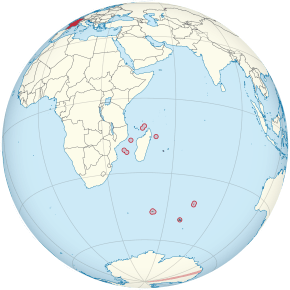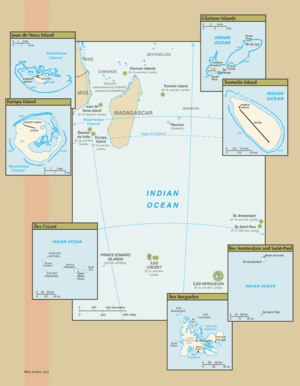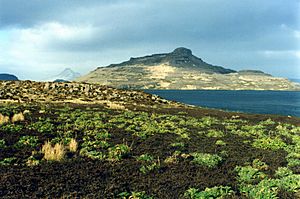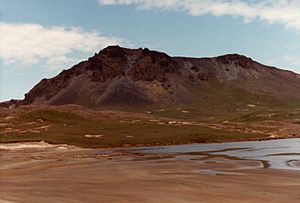French Southern and Antarctic Lands facts for kids
Quick facts for kids
French Southern and Antarctic Lands
Terres australes et antarctiques françaises (French)
|
|||
|---|---|---|---|
|
Overseas territory
|
|||
|
|||
| Motto(s): | |||
| Anthem: La Marseillaise ("The Marseillaise") |
|||

Location of French Southern and Antarctic Lands (circled in red)
in the Indian Ocean (light blue) |
|||
| Sovereign state | |||
| Territorial status | 6 August 1955 | ||
| Capital | Saint Pierre, Réunion (headquarters, not geographically assigned) 43°00′S 67°00′E / 43.000°S 67.000°E |
||
| Largest settlement | Port-aux-Français | ||
| Official languages | French | ||
| Demonym(s) | French | ||
| Leaders | |||
| Emmanuel Macron | |||
|
• Prefect, Administrator Superior
|
Florence Jeanblanc-Risler | ||
|
• Secretary General
|
Amélie Puccinelli | ||
| Legislature | Advisory Council of the TAAF | ||
| Area | |||
|
• Total
|
439,666.4 km2 (169,756.1 sq mi) | ||
| Population | |||
|
• Estimate
|
Officially 400~800 permanent scientists and military personnel No known permanent population |
||
| Currency | Euro (€) (EUR) | ||
| Time zone | |||
| Driving side | right | ||
| ISO 3166 code |
|
||
| Internet TLD | .tf | ||
The French Southern and Antarctic Lands (French: Terres australes et antarctiques françaises, TAAF) is an overseas territory (French: Territoire d'outre-mer or TOM) of France. It consists of:
- Adélie Land (Terre Adélie), the French claim on the continent of Antarctica.
- Crozet Islands (Îles Crozet), a group in the southern Indian Ocean, south of Madagascar.
- Kerguelen Islands (Archipel des Kerguelen), a group of volcanic islands in the southern Indian Ocean, southeast of Africa and southwest of Australia.
- Saint Paul and Amsterdam Islands (Îles Saint Paul et Amsterdam), a group to the north of the Kerguelen Islands.
- Scattered Islands (Îles Éparses), a dispersed group of islands around the coast of Madagascar.
The territory is sometimes referred to as the French Southern Lands (French: Terres australes françaises) or the French Southern Territories, usually to emphasize non-recognition of French sovereignty over Adélie Land as part of the Antarctic Treaty System.
The entire territory has no known permanently settled inhabitants. Approximately 150 (in the winter) to 310 (in the summer) people are usually present in the French Southern and Antarctic Lands at any time, but they are mainly made up of military personnel, officials, scientific researchers and support staff.
On 5 July 2019, the Crozet Islands, the Kerguelen Islands, and the Saint Paul and Amsterdam Islands were inscribed as a UNESCO World Heritage Site as the "French Austral Lands and Seas" because of their pristine wilderness, biodiversity, and enormous bird colonies.
Contents
History
The French Southern and Antarctic Lands are an overseas territory of France that consist of the following:
- Adélie Land (Terre Adélie): This is the French claim on the continent of Antarctica.
- Crozet Islands (Îles Crozet): A group of islands in the southern Indian Ocean, located south of Madagascar.
- Kerguelen Islands (Archipel des Kerguelen): A volcanic island group in the southern Indian Ocean, southeast of Africa.
- Saint Paul and Amsterdam Islands (Îles Saint Paul et Amsterdam): A group of islands to the north of the Kerguelen Islands.
- Scattered Islands (Îles Éparses): A dispersed group of islands around the coast of Madagascar.
The islands became known in the 16th century, when the Spanish discovered Amsterdam Island on 18 March 1522, which was later claimed and named by the Dutch. Saint Paul Island was discovered in 1559 by the Portuguese. The Crozet islands were discovered on 24 January 1772 by French explorer Marc-Joseph Marion du Fresne during an expedition. Adelie Land was the last to be discovered, in 1840 by the French during an expedition led by Jules Dumont d'Urville, who would later have a research station on the island named after him.
The entire territory has no known permanently settled inhabitants. It is mainly visited by military personnel, officials, scientific researchers, and support staff. In 2019, the Crozet Islands, Kerguelen Islands, and Saint Paul and Amsterdam Islands were inscribed as a UNESCO World Heritage Site due to their pristine wilderness, biodiversity, and enormous bird colonies.
Administration
The French Southern and Antarctic Lands have formed a territoire d'outre-mer (an overseas territory) of France since 1955. Formerly, they were administered from Paris by an administrateur supérieur assisted by a secretary-general; since December 2004, however, their administrator has been a préfet, currently Florence Jeanblanc-Risler, with headquarters in Saint Pierre on Réunion Island.
The TAAF administration, the French Polar Institute Paul-Émile Victor (IPEV) and the French Navy jointly operate the icebreaker Astrolabe which is based out of Reunion. The vessel is used both to bring personnel and supplies to the Dumont d'Urville Station and for research and patrol duties. The French armed forces also maintain small troop contingents on some of the Scattered Islands in order to protect the French territorial claim.
The territory is divided into five districts:
| District | Administrative centre | Population | Area | EEZ | |
|---|---|---|---|---|---|
| Winter | Summer | (km2) | |||
| Adélie Land | Dumont d'Urville Station | 30 | 110 | 432,000 | — |
| Crozet Islands | Alfred Faure | 25 | 45 | 352 | 567,475 |
| Kerguelen Islands | Port-aux-Français | 70 | 110 | 7,215 | 563,869 |
| Saint Paul and Amsterdam Islands | Martin-de-Viviès | 25 | 45 | 61 | 502,533 |
| Scattered Islandsa | Saint Pierreb, Réunion | 56 | 56 | 38.4 | 640,400 |
| TAAF | Saint Pierrec, Réunion | 206 | 366 | 439,666.4 | 2,274,277 |
a According to new law 2007-224 of February 21, 2007, the Scattered Islands constitute the TAAF's fifth district. The TAAF website does not mention their population. The data are not included in the totals.
b The Îles Éparses principal station is on Tromelin Island. The headquarters of the district chief lies beyond the TAAF, in Saint Pierre on Réunion Island.
c The Territory's principal station is Martin-de-Viviès on Amsterdam Island. The capital and headquarters of the territorial administrator lies beyond the TAAF, in Saint Pierre on Réunion Island.
Each district is headed by a district chief, who has powers similar to those of a French mayor (including recording births and deaths and being an officer of judicial police).
Because there is no permanent population, there is no elected assembly, nor does the territory send representatives to the national parliament.
Geography

Adélie Land (in Antarctica) and Banc du Geyser and Bassas da India (in the Îles Éparses district) are not shown.

The territory includes the Crozet Islands, the Kerguelen Islands, and the Saint Paul and Amsterdam Islands in the southern Indian Ocean near 43°S, 67°E, along with Adélie Land, the sector of Antarctica claimed by France. Adélie Land, named by the French explorer Jules Dumont d’Urville after his wife, covers about 432,000 km2 (167,000 sq mi). The islands, totaling 7,781 km2 (3,004 sq mi), have no indigenous inhabitants, although in 1997 there were approximately 100 researchers whose numbers varied from winter (July) to summer (January).
Amsterdam Island and Saint Paul Island are both extinct volcanoes and have been delineated as the Amsterdam and Saint-Paul Islands temperate grasslands ecoregion. The highest point in the territory is Mont Ross on Kerguelen Island, standing at 1,850 m (6,070 ft). Notably, there are very few airstrips on the islands, existing only on islands with weather stations. The 1,232 km (766 mi) of coastline lacks ports or harbors, offering only offshore anchorages.
The islands in the Indian Ocean receive supplies via the special ship Marion Dufresne, which sails out of Le Port in Réunion Island. Terre Adélie, the Antarctic sector claimed by France, is supplied by L’Astrolabe, which sails out of Hobart in Tasmania.
Regarding maritime activity, the territory maintains a merchant marine fleet totaling (as of 1999) 2,892,911 GRT/5,165,713 tonnes deadweight (DWT). This fleet includes seven bulk carriers, five cargo ships, ten chemical tankers, nine container ships, six liquefied gas carriers, 24 petroleum tankers, one refrigerated cargo ship, and ten roll-on/roll-off (RORO) carriers. Notably, this fleet operates under the French register, allowing French-owned ships to benefit from more liberal taxation and manning regulations than those permissible under the main French register. However, this register is expected to be replaced by the International French Register (Registre International Français, RIF) in the future.
Flora and fauna
|
Designations
|
|
| Official name: French Austral Lands and Seas | |
| Criteria: | Natural: (vii), (ix), (x) |
|---|---|
| Designated: | 2019 (43rd session) |
| Reference #: | 1603 |
| Region: | Western Europe |
| Official name: Réserve Naturelle Nationale des Terres Australes Francaises | |
| Designated: | 15 September 2008 |
| Reference #: | 1837 |
Due to their isolation, the French islands in the southern Indian Ocean comprise one of the last remaining large wilderness areas on Earth. Furthermore, the islands are positioned along the Antarctic Convergence, where upwelling creates nutrient-rich waters. As a result, birds and marine mammals gather on the islands in great abundance. More than 50 million birds of 47 species breed on the islands, including more than half the breeding population of 16 different species. The largest populations of king penguins and the endangered Indian yellow-nosed albatross on Earth are found on the Crozet Islands and Amsterdam Island, respectively. Other threatened bird species with important populations on the islands include Eaton's pintail, MacGillivray's prion, and the Amsterdam albatross, which is one of four bird species endemic to the island group. The French Southern Lands also hold the second largest population of southern elephant seals on Earth, numbering roughly 200,000, and the third largest population of the Antarctic fur seal.
Because of their isolation and subpolar location, the French Southern Lands are relatively depauperate of vegetation, with both Saint-Paul and Crozet having no native tree or shrub species. However, eight of the 36 higher plant species are endemic. Some species of endemic invertebrates have also been recorded on the islands, including moths and flies which have lost their wings in the absence of predators.
Economy
The territory's natural resources are limited to fish and crustaceans. Economic activity is limited to servicing meteorological and geophysical research stations and French and other fishing fleets.
The main fish resources are Patagonian toothfish and spiny lobster. Both are poached by foreign fleets; because of this, the French Navy, and occasionally other services, patrol the zone and arrest poaching vessels. Such arrests can result in heavy fines or the seizure of the ship.
France previously sold licenses to foreign fisheries to fish the Patagonian toothfish; because of overfishing, it is now restricted to a small number of fisheries from Réunion Island.
The territory takes in revenues of about €16 million a year.
Locations and scientific stations
While the territory lacks a permanent civilian population, there are several inhabited research stations. Île Amsterdam has a meteorological station. Îles Crozet contains the Alfred Faure research station with a population of about 20-30 people. One of the most populous research stations in the Îles Kerguelen, Port-aux-Francais, contains 50-100 researchers. The Îles Éparses contains a French military garrison and is a spot for meteorology. The Dumont d’Urville station is a vital area for studying wildlife, the atmosphere and the ice caps.
Codes
The French Southern Territories (i.e. the TAAF excluding Adélie Land) have been given the following country codes: FS (FIPS) and TF (ISO 3166-1 alpha-2).
See also
 In Spanish: Tierras Australes y Antárticas Francesas para niños
In Spanish: Tierras Australes y Antárticas Francesas para niños
- Administrative divisions of France
- French colonial empire
- French Fifth Republic
- List of French islands in the Indian and Pacific oceans
- List of French possessions and colonies
- Outline of France
- Overseas France




